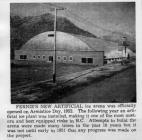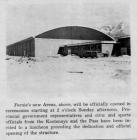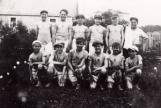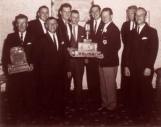46
Fernie Arena, during the flood of 1948Note the curling rink, at left, named the "Roarin' Game Limited."
Damage caused by the flood of 1948 led to the decision to rebuild the Fernie Arena on higher ground, on the present site.
Courtesy of William Quail
47
Fernie's New Community Arena' From The Fernie Free Press, November 13, 195213 November 1952
Fernie

48
A New ArenaA new arena, operated by the City of Fernie, was built on the present grounds and opened in 1952. During its official opening, Mayor Tom Uphill proclaimed that "no city with a population equal to that of Fernie's had an arena comparable." With room for up to 1300 spectators and two pairs of curling sheets underneath the opposing stands, the Fernie Community Arena was an impressive facility. It was destroyed by fire in 1959 and claimed the life of Junior hockey player Dominic Ferrarelli.
"Fernie's New Community Arena"
From The Fernie Free Press, November 13, 1952
49
'Plans Completed for Rink Opening' From The Fernie Free Press, January 28, 196028 January 1960
Fernie

50
The arena was promptly rebuilt for the following playing season in 1960. Curlers, skaters and hockey players eagerly awaited its opening in January. Local businesses and clubs rallied to help purchase and finance equipment for the new facility. Over the years, the Fernie Arena has hosted numerous sport events, including the BC Winter Games in 1987. The arena continues to serve the city well."Plans Completed for Rink Opening"
From The Fernie Free Press, January 28, 1960
51
AutonomyThough players from Fernie competed seriously at various levels, playing team sports here generally remained informal. Frequently, children and adults of various ages formed opposing teams using as many of them as were available to play informal games well into the evenings. A certain level of spontaneity also pervaded Fernie's city hockey, soccer and baseball leagues, with players generally agreeing among themselves when to practice. They usually met after supper, walking, biking or even canoeing to their chosen field or rink. Walking or hitching a ride between Fernie and Coal Creek, five miles to the east, to practice was a long but frequent journey. As they grew older, these players continued to enjoy the same autonomy, seeking guidance from their team coaches and managers only as needed.
53
West Fernie Midget football team, 1937Gathered by themselves amid a backyard garden, these boys portray the autonomous, informal nature of sports in Fernie during the early twentieth century.
Courtesy of Angus Dunlap(Moke)
55
Coal Creek skating rink, c. late 1920'sPlayers from the Coal Creek hockey team stop during practice for an informal photograph. The two players on opposite ends also played for the Fernie Bluebirds All-star team.
Courtesy of William Milburn
57
Crows Nest Industries mine rescue team, 1967The Elk Valley teammates proudly display the trophies they won at the BC and Canadian Mine Rescue Championships in Trail. They would go on to compete in the "World Series of Safety" in Kentucky.
Courtesy of William Milburn
58
FriendshipsAt regional levels of play, teammates developed lasting friendships through their many shared experiences. Traveling overnight to soccer games in Calgary or hockey games in Great Falls and Spokane, though often tiresome, enabled players to get to know each other more closely. They were also united in their commitment to play, even though it involved much time away from home. Following home games, teammates frequently unwound at the Fernie Hotel. On occasion, they even joined opposing teams in celebration. While they competed aggressively, they always wished the other team well when they lost. With this attitude, many Fernie players also developed lasting friendships with their opponents.



